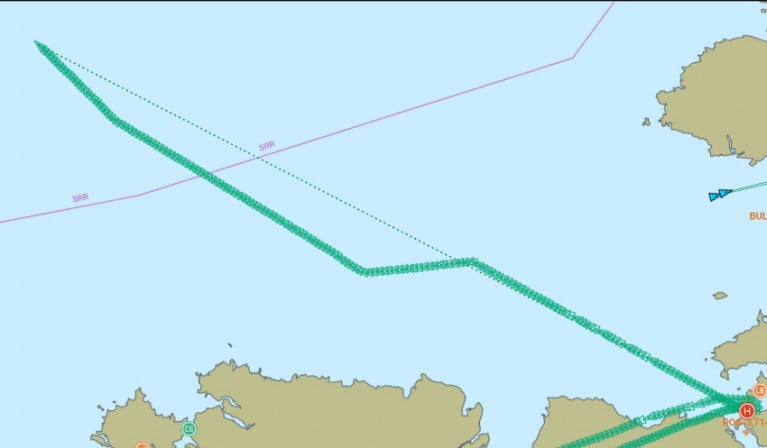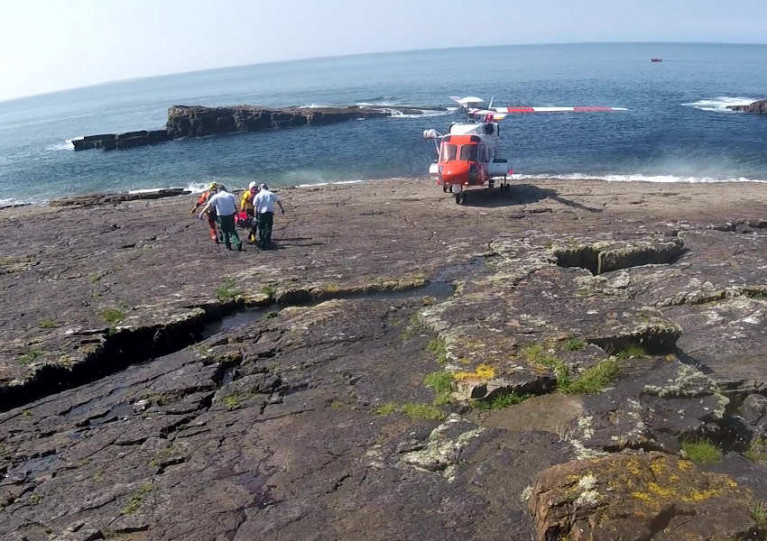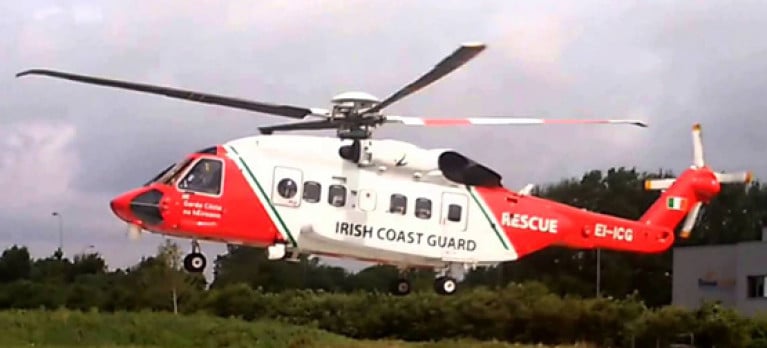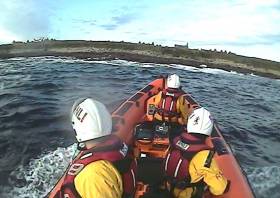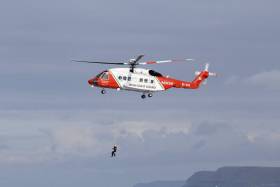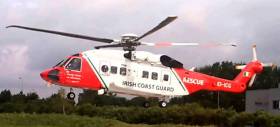Displaying items by tag: Rescue 118
Both Clifden lifeboats were launched on Monday morning (13 March) to conduct a search after an EPIRB distress signal was detected by Malin Head Coast Guard in the area around Letterfrack in Co Galway.
An EPIRB, or emergency position indicating radio beacon, is a device to alert search and rescue services in case of an emergency out at sea.
Deputy launching authority Saul Joyce launched Clifden RNLI’s Shannon class all-weather lifeboat St Christopher under the command of coxswain Alan Pryce with mechanic Joe Acton, navigator Dan Whelan and crew of Andy Bell, Chris Nee and John Heffernan.
The all-weather lifeboat made best speed to the search area of Mullaghloss on the Renvyle peninsula. While that boat was en route and with more information becoming available, Clifden RNLI’s Atlantic 85 was launched with Thomas Davis at the helm and crew of Kevin Ryan and Shane Conneely.
The Irish Coast Guard’s Sligo-based helicopter Rescue 118 was also tasked to search along with Cleggan Coast Guard units.
An extensive search was carried out of the reported areas by all assets with a large portion of the north Connemara coast searched. With all involved satisfied that there was no vessel in distress in the area, the coastguard stood down all assets and the volunteer crews returned to station.
Clifden RNLI coxswain Alan Pryce said Monday’s call “demonstrates how a well coordinated multi-agency search can cover a very large area thoroughly and efficiently.
“Thankfully there was no vessel in distress on this occasion but we remain ready to respond every time the pager goes.”
Speaking about EPIRBs, Pryce added: “Emergency beacons are a lifesaving piece of equipment, I would encourage any boat owners to check the service status and registration details of any beacons on board. If you don’t have an EPIRB you should consider getting one because they will help search and rescue services to pinpoint the location of a vessel in distress.”
Sailors Recovering After Yacht Washes Ashore on Achill Island
Two sailors are recovering after their yacht washed ashore on Achill Island and was beached for three days before the alarm was raised, as RTÉ News reports.
The 50-foot boat is understood to have got into difficulty amid stormy conditions in the Atlantic in the middle of last week and washed ashore near Dooega Head on the Co Mayo island after capsizing.
But it was a further three days, on Friday (11 November), when one of the two crew climbed up the cliff to seek help.
The other crew member was rescued by the Irish Coast Guard’s Sligo-based helicopter Rescue 118 and airlifted to hospital.
According to the Irish Examiner, the two sailors say they were en route from the Caribbean to Ibiza before the incident.
But it’s also emerged that neither sailor was carrying identifying documents, and that the boat had no navigation equipment, distress signal nor food or water on board.
The volunteer crew of Bundoran RNLI were called out on Wednesday afternoon (27 October) to reports of a cow in distress in the surf at Tullan Strand in the Donegal town.
A passer-by had spotted the animal in the water and immediately alerted the Irish Coast Guard at Malin Head who in turn paged the lifeboat crew.
The four crew launched the inshore lifeboat just after 4.30pm and made their way in rough seas to Tullan Strand to assess the situation, while a number of other volunteer crew attended via the shore to offer visual backup to the lifeboat crew.
As the swell was between three and four metres, conditions were difficult for the lifeboat to get closer to the shore with visibility of the cow also tricky for the shore crew.
 Daisy Mae following her rescue on Wednesday | Credit: Daimon Fergus
Daisy Mae following her rescue on Wednesday | Credit: Daimon Fergus
The animal was soon spotted, however, by which time the Sligo-based coastguard helicopter Rescue 118 was on scene. Using the noise and downdraft of the helicopter, its crew were able to encourage the cow back to safety on the shore.
Both the lifeboat and helicopter stayed on scene to ensure the safety of the cow which was tended to on shore before both units were stood down.
Speaking on return to the lifeboat station, Bundoran RNLI helm Michael Patton said: “We were delighted to see a successful outcome from today’s callout and would like to thank those who assisted in the rescue of the cow.
“If you are ever worried that your pet or animal is in danger, call 999 or 112 and ask for the coastguard, rather than putting yourself at risk by going into the water after them.”
One Airlifted to Hospital After Jet Skiing Incident on River Foyle
One person was airlifted to hospital after a personal watercraft ran aground on the River Foyle, as the Belfast Telegraph reports.
The Irish Coast Guard’s Sligo-based helicopter Rescue 118 was dispatched to the incident in Lisahally, Co Derry last night (Saturday 25 September) in which one person is said to have sustained a serious head injury.
That casualty was airlifted to Altnagelvin Area Hospital in Derry, while another individual was rescued by a team from Foyle Search & Rescue.
Coastguard units from Greencastle in Co Donegal and Coleraine were also in attendance as part of the multi-agency operation, along with the PSNI and Northern Ireland Fire and Rescue Service.
Rescue 118 In Long-Range Medevac From Container Ship
Sligo’s Irish Coast Guard helicopter Rescue 118 was tasked yesterday (Friday 28 August) for a medevac from a container ship west of Tory Island.
The Sikorsky S-92 completed the 190-nautical mile round trip to retrieve the sick crewman from the MSC Sao Paulo for treatment on land.
Woman Rescued After Fall From Cliff At Mullaghmore Head
A woman rescued after falling from a cliff at Mullaghmore Head yesterday afternoon (Thursday 13 August) was “very lucky that she was spotted”.
The casualty was found unconscious at the bottom of the cliff on the Co Sligo headland by concerned passers-by who alerted the Irish Coast Guard.
Bundoran’s RNLI lifeboat volunteers and the Sligo-based coastguard helicopter Rescue 118 were both called out to the scene.
And the woman was treated by helicopter and ambulance crew before being airlifted to Sligo University Hospital.
Bundoran lifeboat crew member Rory O’Connor commented: “The casualty was very lucky that she was spotted and that the alert was raised so quickly.
“We would remind anyone that if they see anyone in trouble on the coast to ring 999 or 112 and ask for the coastguard.”
Calls For Surfers To ‘Foot The Bill’ For Rescues During Storm Conditions After Two Taken From Water In Storm Jorge
Calls have been made for people rescued from the water while going against safety advice and weather warnings to be “handed the bill” for their rescue, after two surfers were saved off the Sligo coast during Storm Jorge at the weekend.
The Irish Times reports that the two surfers were winched aboard the Sligo-based Irish Coast Guard helicopter Rescue 118 on Saturday morning (29 February) after one had lost his surfboard and another on shore had attempted to rescue him.
Storm conditions such as those presented by Storm Jorge — which prompted a Status Red marine warning for all Irish coastal waters — create the swells sought after by the big wave surfers regularly attracted to the Sligo coast, particularly at Mullaghmore, over the winter months.
But the situation on Saturday did not sit well with members of the public commenting online, who branded the surfers’ actions as “selfish” and “nonsense” and demanded they foot “the bill” for the launch of emergency services, or even face criminal prosecution.
The Irish Times has more on the story HERE.
Four Rescued From Co Sligo Island After Vessel Capsizes
Four people have been rescued from an island off the Sligo coast after their vessel washed up on rocks.
Bundoran RNLI’s volunteer crew launched to the incident at Inishmurray Island yesterday afternoon (Sunday 3 November) along with the Irish Coast Guard’s Sligo-based helicopter Rescue 118, which airlifted the casualties to hospital
The RNLI says the lifeboat made efforts to recover their boat from the rocks but due to a three-metre swell, it was decided to leave it in place.
Later, volunteer helm Rory O’Connor said: “The four casualties were lucky on this occasion and we are thankful that they alerted the coastguard when they did. This was another callout with a good outcome.”
Irish Coast Guard Rescues 15 From Sea In Donegal
RTÉ News reports that 15 young people were rescued from the sea off Donegal yesterday afternoon (Tuesday 13 August).
Ten were airlifted to hospital in Letterkenny after the group got into difficulty while swimming by the pier at Magheroarty in north-west Donegal, according to the Irish Coast Guard.
Several emergency calls were reportedly made by onlookers at the scene, where the Mulroy coastguard unit and Tory Island ferry Queen of Aran also stood by to assist.
A spokesperson for the Irish Coast Guard acknowledged the fortunate outcome, and singled out the crew of the Sligo-based SAR helicopter Rescue 118 “for their efficient response to a difficult challenge”.
Man Dies After Fishing Boat Capsize Off Mayo
The Irish Mirror reports that a man has died after a fishing boat capsized off the Mayo coast yesterday afternoon (Tuesday 10 April).
It’s understood that the deceased was a man in his 50s from North Mayo. He was one of three men recovered from a life raft some 16 miles off Eagle Island after their vessel sank.
Ballyglass RNLI and the Irish Coast Guard’s Sligo-based helicopter Rescue 118 were immediately tasked to search the area when a Mayday broadcast was picked up shortly after 12.30pm.
Rescue 118 spotted flares less than an hour later and proceeded to airlift the casualties for transfer to Sligo University Hospital.


























